The healthcare reimbursement plans
VerifiedAdded on 2022/08/26
|16
|4815
|30
AI Summary
Contribute Materials
Your contribution can guide someone’s learning journey. Share your
documents today.
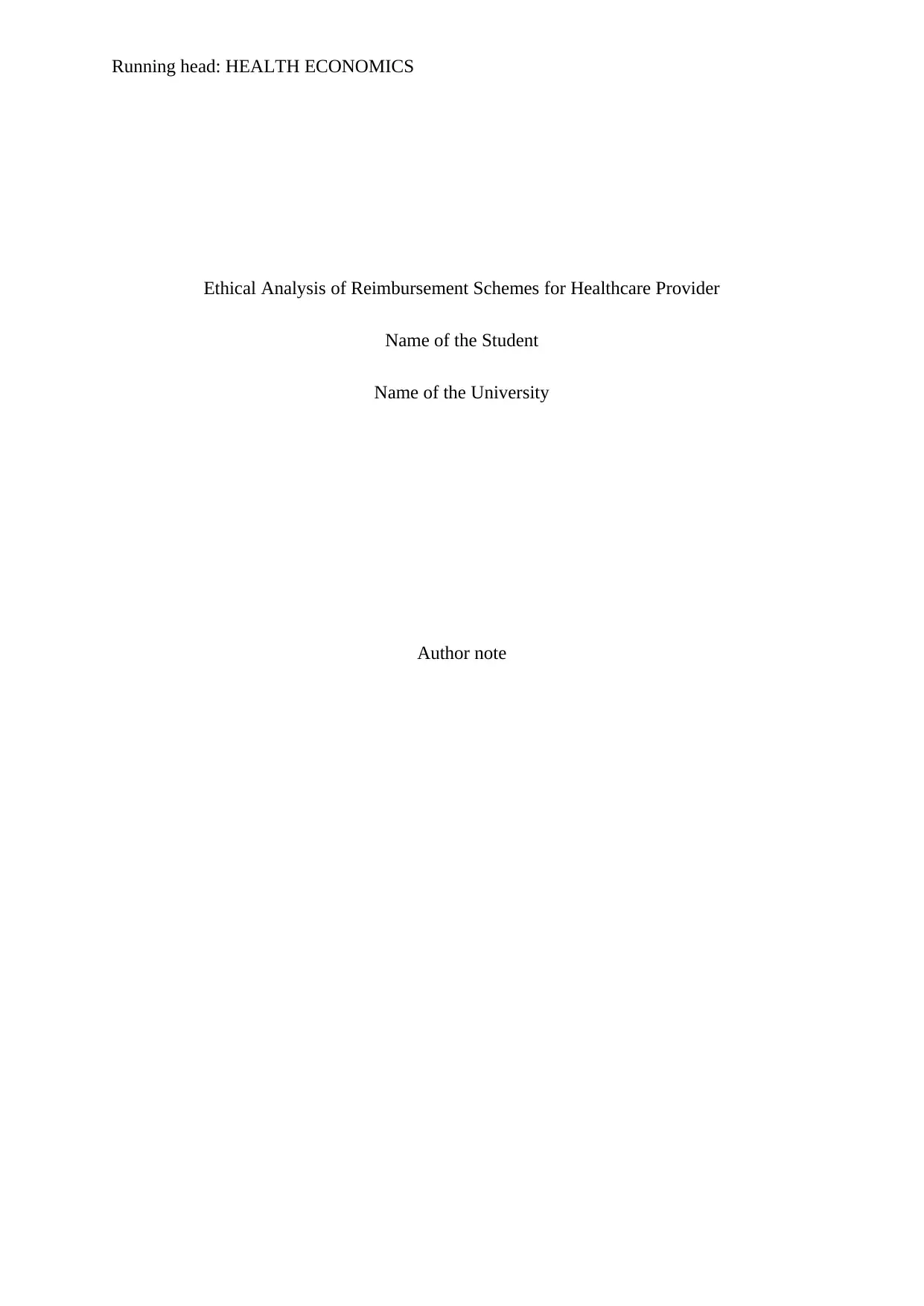
Running head: HEALTH ECONOMICS
Ethical Analysis of Reimbursement Schemes for Healthcare Provider
Name of the Student
Name of the University
Author note
Ethical Analysis of Reimbursement Schemes for Healthcare Provider
Name of the Student
Name of the University
Author note
Secure Best Marks with AI Grader
Need help grading? Try our AI Grader for instant feedback on your assignments.
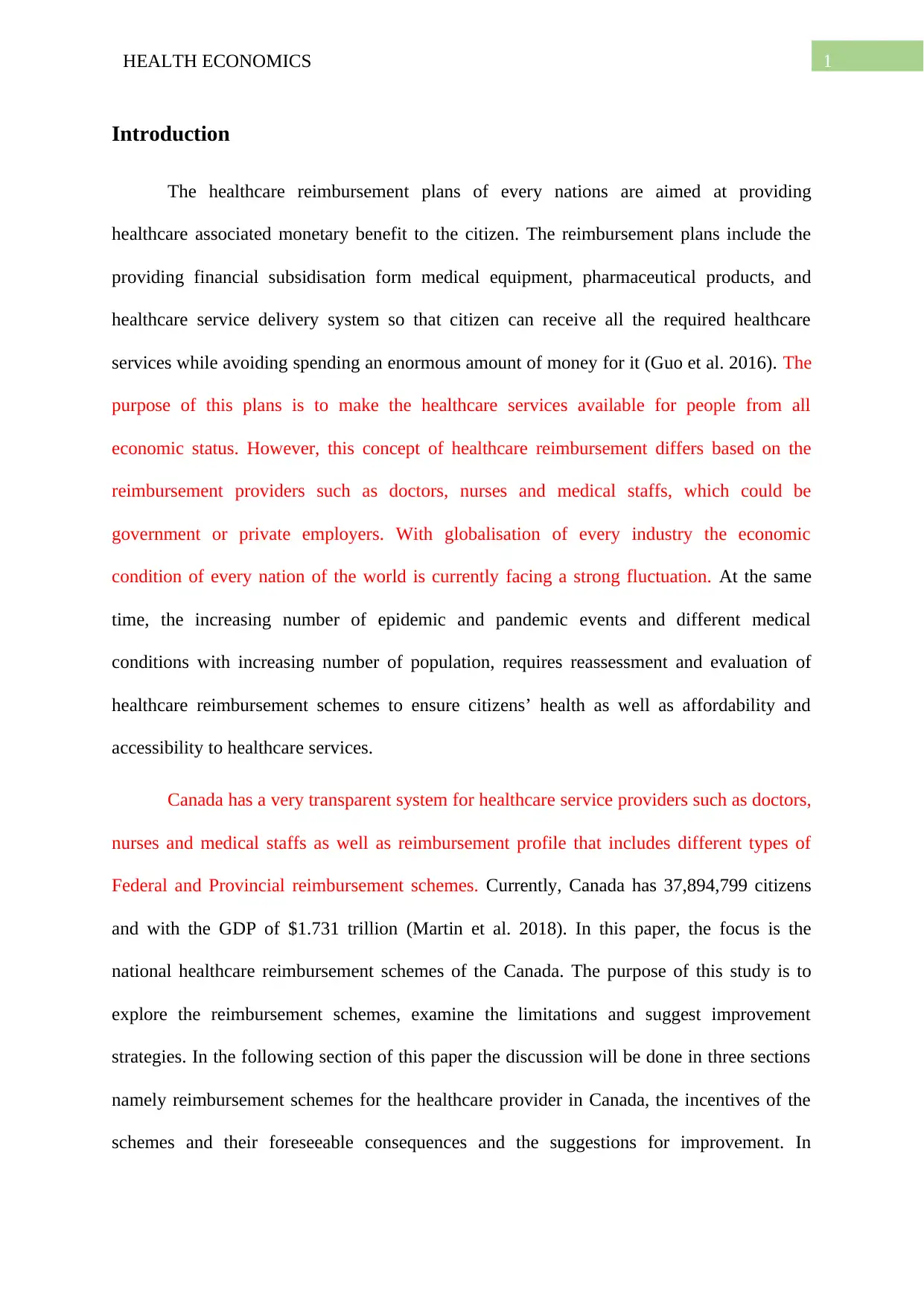
1HEALTH ECONOMICS
Introduction
The healthcare reimbursement plans of every nations are aimed at providing
healthcare associated monetary benefit to the citizen. The reimbursement plans include the
providing financial subsidisation form medical equipment, pharmaceutical products, and
healthcare service delivery system so that citizen can receive all the required healthcare
services while avoiding spending an enormous amount of money for it (Guo et al. 2016). The
purpose of this plans is to make the healthcare services available for people from all
economic status. However, this concept of healthcare reimbursement differs based on the
reimbursement providers such as doctors, nurses and medical staffs, which could be
government or private employers. With globalisation of every industry the economic
condition of every nation of the world is currently facing a strong fluctuation. At the same
time, the increasing number of epidemic and pandemic events and different medical
conditions with increasing number of population, requires reassessment and evaluation of
healthcare reimbursement schemes to ensure citizens’ health as well as affordability and
accessibility to healthcare services.
Canada has a very transparent system for healthcare service providers such as doctors,
nurses and medical staffs as well as reimbursement profile that includes different types of
Federal and Provincial reimbursement schemes. Currently, Canada has 37,894,799 citizens
and with the GDP of $1.731 trillion (Martin et al. 2018). In this paper, the focus is the
national healthcare reimbursement schemes of the Canada. The purpose of this study is to
explore the reimbursement schemes, examine the limitations and suggest improvement
strategies. In the following section of this paper the discussion will be done in three sections
namely reimbursement schemes for the healthcare provider in Canada, the incentives of the
schemes and their foreseeable consequences and the suggestions for improvement. In
Introduction
The healthcare reimbursement plans of every nations are aimed at providing
healthcare associated monetary benefit to the citizen. The reimbursement plans include the
providing financial subsidisation form medical equipment, pharmaceutical products, and
healthcare service delivery system so that citizen can receive all the required healthcare
services while avoiding spending an enormous amount of money for it (Guo et al. 2016). The
purpose of this plans is to make the healthcare services available for people from all
economic status. However, this concept of healthcare reimbursement differs based on the
reimbursement providers such as doctors, nurses and medical staffs, which could be
government or private employers. With globalisation of every industry the economic
condition of every nation of the world is currently facing a strong fluctuation. At the same
time, the increasing number of epidemic and pandemic events and different medical
conditions with increasing number of population, requires reassessment and evaluation of
healthcare reimbursement schemes to ensure citizens’ health as well as affordability and
accessibility to healthcare services.
Canada has a very transparent system for healthcare service providers such as doctors,
nurses and medical staffs as well as reimbursement profile that includes different types of
Federal and Provincial reimbursement schemes. Currently, Canada has 37,894,799 citizens
and with the GDP of $1.731 trillion (Martin et al. 2018). In this paper, the focus is the
national healthcare reimbursement schemes of the Canada. The purpose of this study is to
explore the reimbursement schemes, examine the limitations and suggest improvement
strategies. In the following section of this paper the discussion will be done in three sections
namely reimbursement schemes for the healthcare provider in Canada, the incentives of the
schemes and their foreseeable consequences and the suggestions for improvement. In
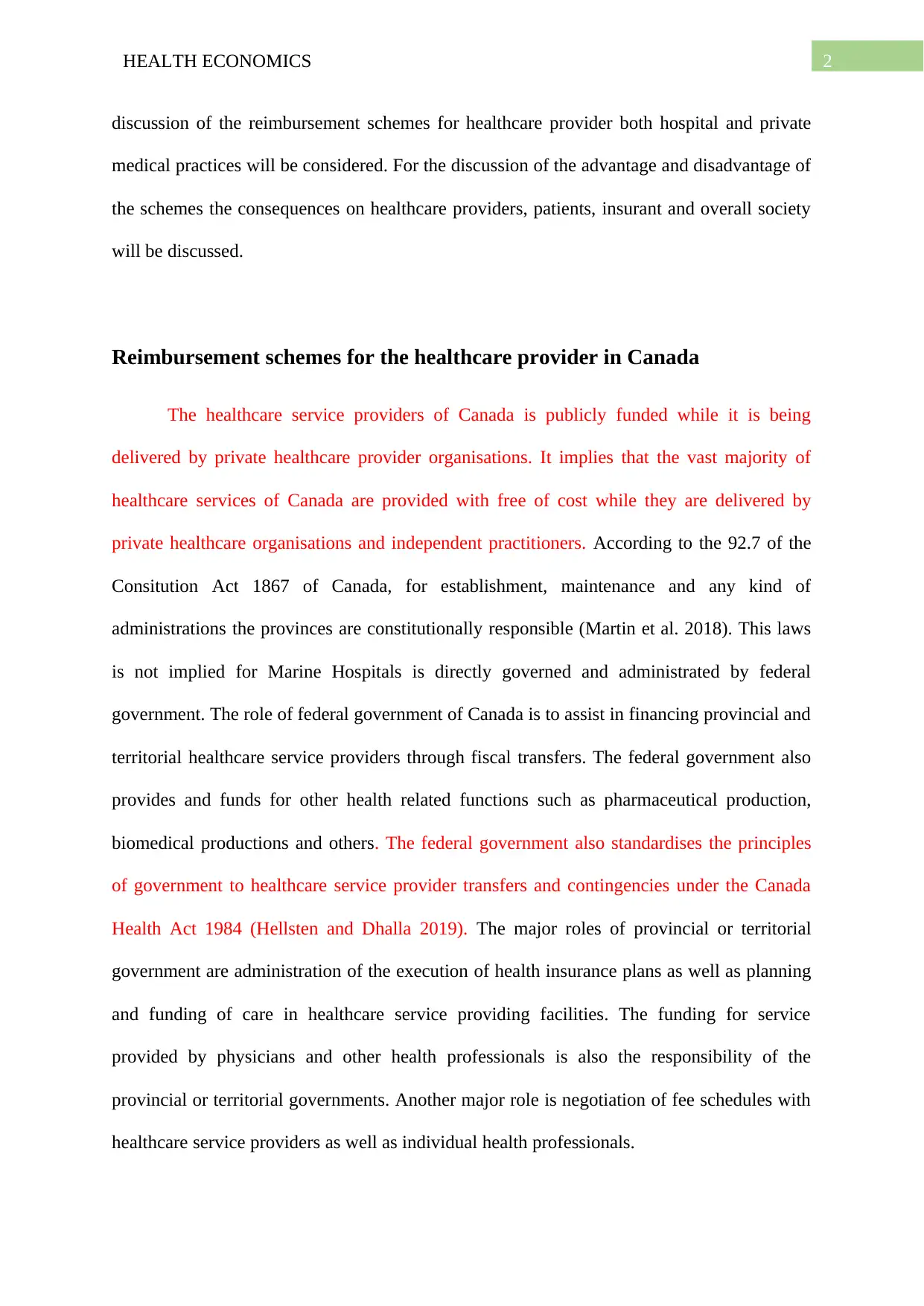
2HEALTH ECONOMICS
discussion of the reimbursement schemes for healthcare provider both hospital and private
medical practices will be considered. For the discussion of the advantage and disadvantage of
the schemes the consequences on healthcare providers, patients, insurant and overall society
will be discussed.
Reimbursement schemes for the healthcare provider in Canada
The healthcare service providers of Canada is publicly funded while it is being
delivered by private healthcare provider organisations. It implies that the vast majority of
healthcare services of Canada are provided with free of cost while they are delivered by
private healthcare organisations and independent practitioners. According to the 92.7 of the
Consitution Act 1867 of Canada, for establishment, maintenance and any kind of
administrations the provinces are constitutionally responsible (Martin et al. 2018). This laws
is not implied for Marine Hospitals is directly governed and administrated by federal
government. The role of federal government of Canada is to assist in financing provincial and
territorial healthcare service providers through fiscal transfers. The federal government also
provides and funds for other health related functions such as pharmaceutical production,
biomedical productions and others. The federal government also standardises the principles
of government to healthcare service provider transfers and contingencies under the Canada
Health Act 1984 (Hellsten and Dhalla 2019). The major roles of provincial or territorial
government are administration of the execution of health insurance plans as well as planning
and funding of care in healthcare service providing facilities. The funding for service
provided by physicians and other health professionals is also the responsibility of the
provincial or territorial governments. Another major role is negotiation of fee schedules with
healthcare service providers as well as individual health professionals.
discussion of the reimbursement schemes for healthcare provider both hospital and private
medical practices will be considered. For the discussion of the advantage and disadvantage of
the schemes the consequences on healthcare providers, patients, insurant and overall society
will be discussed.
Reimbursement schemes for the healthcare provider in Canada
The healthcare service providers of Canada is publicly funded while it is being
delivered by private healthcare provider organisations. It implies that the vast majority of
healthcare services of Canada are provided with free of cost while they are delivered by
private healthcare organisations and independent practitioners. According to the 92.7 of the
Consitution Act 1867 of Canada, for establishment, maintenance and any kind of
administrations the provinces are constitutionally responsible (Martin et al. 2018). This laws
is not implied for Marine Hospitals is directly governed and administrated by federal
government. The role of federal government of Canada is to assist in financing provincial and
territorial healthcare service providers through fiscal transfers. The federal government also
provides and funds for other health related functions such as pharmaceutical production,
biomedical productions and others. The federal government also standardises the principles
of government to healthcare service provider transfers and contingencies under the Canada
Health Act 1984 (Hellsten and Dhalla 2019). The major roles of provincial or territorial
government are administration of the execution of health insurance plans as well as planning
and funding of care in healthcare service providing facilities. The funding for service
provided by physicians and other health professionals is also the responsibility of the
provincial or territorial governments. Another major role is negotiation of fee schedules with
healthcare service providers as well as individual health professionals.
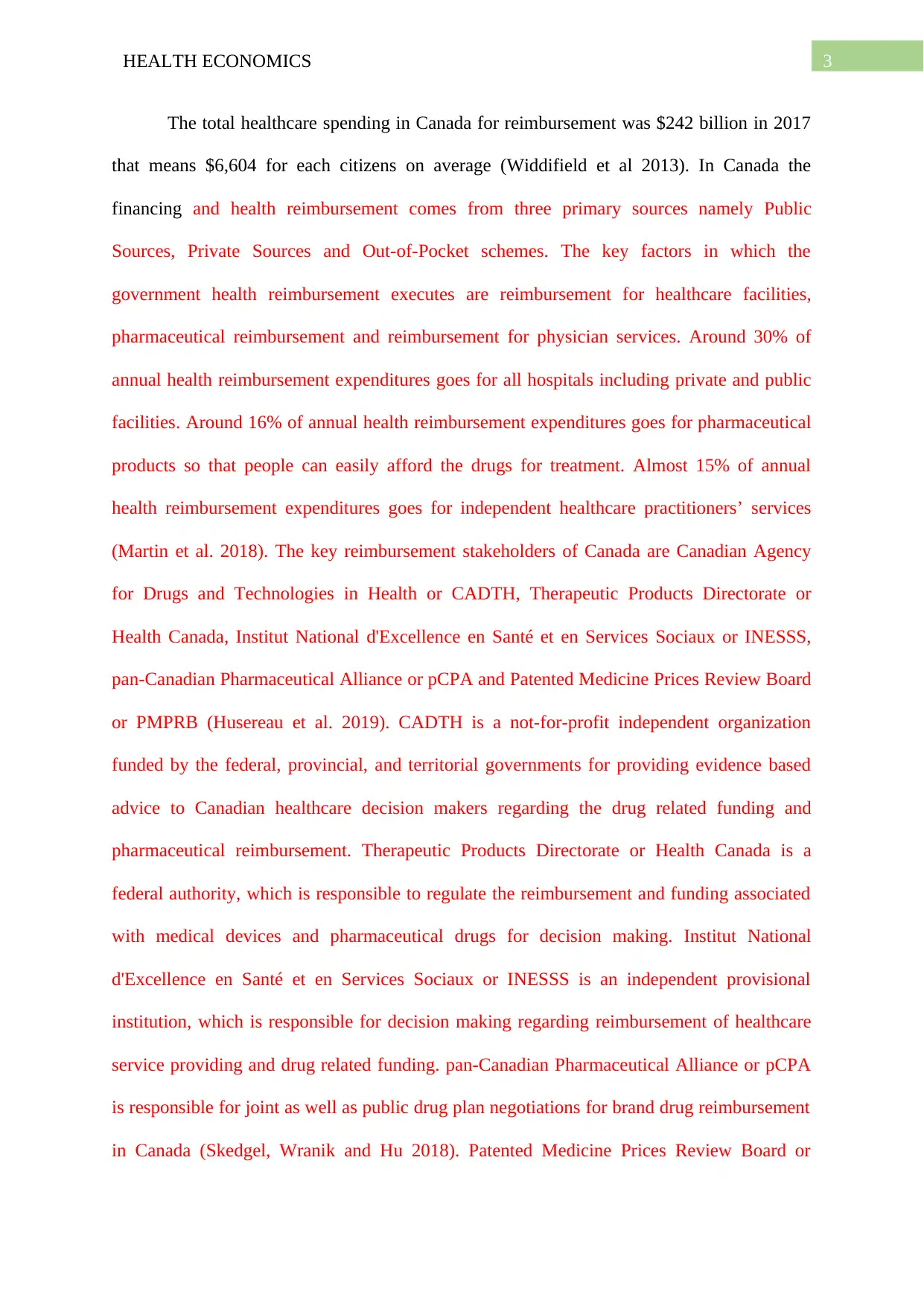
3HEALTH ECONOMICS
The total healthcare spending in Canada for reimbursement was $242 billion in 2017
that means $6,604 for each citizens on average (Widdifield et al 2013). In Canada the
financing and health reimbursement comes from three primary sources namely Public
Sources, Private Sources and Out-of-Pocket schemes. The key factors in which the
government health reimbursement executes are reimbursement for healthcare facilities,
pharmaceutical reimbursement and reimbursement for physician services. Around 30% of
annual health reimbursement expenditures goes for all hospitals including private and public
facilities. Around 16% of annual health reimbursement expenditures goes for pharmaceutical
products so that people can easily afford the drugs for treatment. Almost 15% of annual
health reimbursement expenditures goes for independent healthcare practitioners’ services
(Martin et al. 2018). The key reimbursement stakeholders of Canada are Canadian Agency
for Drugs and Technologies in Health or CADTH, Therapeutic Products Directorate or
Health Canada, Institut National d'Excellence en Santé et en Services Sociaux or INESSS,
pan-Canadian Pharmaceutical Alliance or pCPA and Patented Medicine Prices Review Board
or PMPRB (Husereau et al. 2019). CADTH is a not-for-profit independent organization
funded by the federal, provincial, and territorial governments for providing evidence based
advice to Canadian healthcare decision makers regarding the drug related funding and
pharmaceutical reimbursement. Therapeutic Products Directorate or Health Canada is a
federal authority, which is responsible to regulate the reimbursement and funding associated
with medical devices and pharmaceutical drugs for decision making. Institut National
d'Excellence en Santé et en Services Sociaux or INESSS is an independent provisional
institution, which is responsible for decision making regarding reimbursement of healthcare
service providing and drug related funding. pan-Canadian Pharmaceutical Alliance or pCPA
is responsible for joint as well as public drug plan negotiations for brand drug reimbursement
in Canada (Skedgel, Wranik and Hu 2018). Patented Medicine Prices Review Board or
The total healthcare spending in Canada for reimbursement was $242 billion in 2017
that means $6,604 for each citizens on average (Widdifield et al 2013). In Canada the
financing and health reimbursement comes from three primary sources namely Public
Sources, Private Sources and Out-of-Pocket schemes. The key factors in which the
government health reimbursement executes are reimbursement for healthcare facilities,
pharmaceutical reimbursement and reimbursement for physician services. Around 30% of
annual health reimbursement expenditures goes for all hospitals including private and public
facilities. Around 16% of annual health reimbursement expenditures goes for pharmaceutical
products so that people can easily afford the drugs for treatment. Almost 15% of annual
health reimbursement expenditures goes for independent healthcare practitioners’ services
(Martin et al. 2018). The key reimbursement stakeholders of Canada are Canadian Agency
for Drugs and Technologies in Health or CADTH, Therapeutic Products Directorate or
Health Canada, Institut National d'Excellence en Santé et en Services Sociaux or INESSS,
pan-Canadian Pharmaceutical Alliance or pCPA and Patented Medicine Prices Review Board
or PMPRB (Husereau et al. 2019). CADTH is a not-for-profit independent organization
funded by the federal, provincial, and territorial governments for providing evidence based
advice to Canadian healthcare decision makers regarding the drug related funding and
pharmaceutical reimbursement. Therapeutic Products Directorate or Health Canada is a
federal authority, which is responsible to regulate the reimbursement and funding associated
with medical devices and pharmaceutical drugs for decision making. Institut National
d'Excellence en Santé et en Services Sociaux or INESSS is an independent provisional
institution, which is responsible for decision making regarding reimbursement of healthcare
service providing and drug related funding. pan-Canadian Pharmaceutical Alliance or pCPA
is responsible for joint as well as public drug plan negotiations for brand drug reimbursement
in Canada (Skedgel, Wranik and Hu 2018). Patented Medicine Prices Review Board or
Secure Best Marks with AI Grader
Need help grading? Try our AI Grader for instant feedback on your assignments.
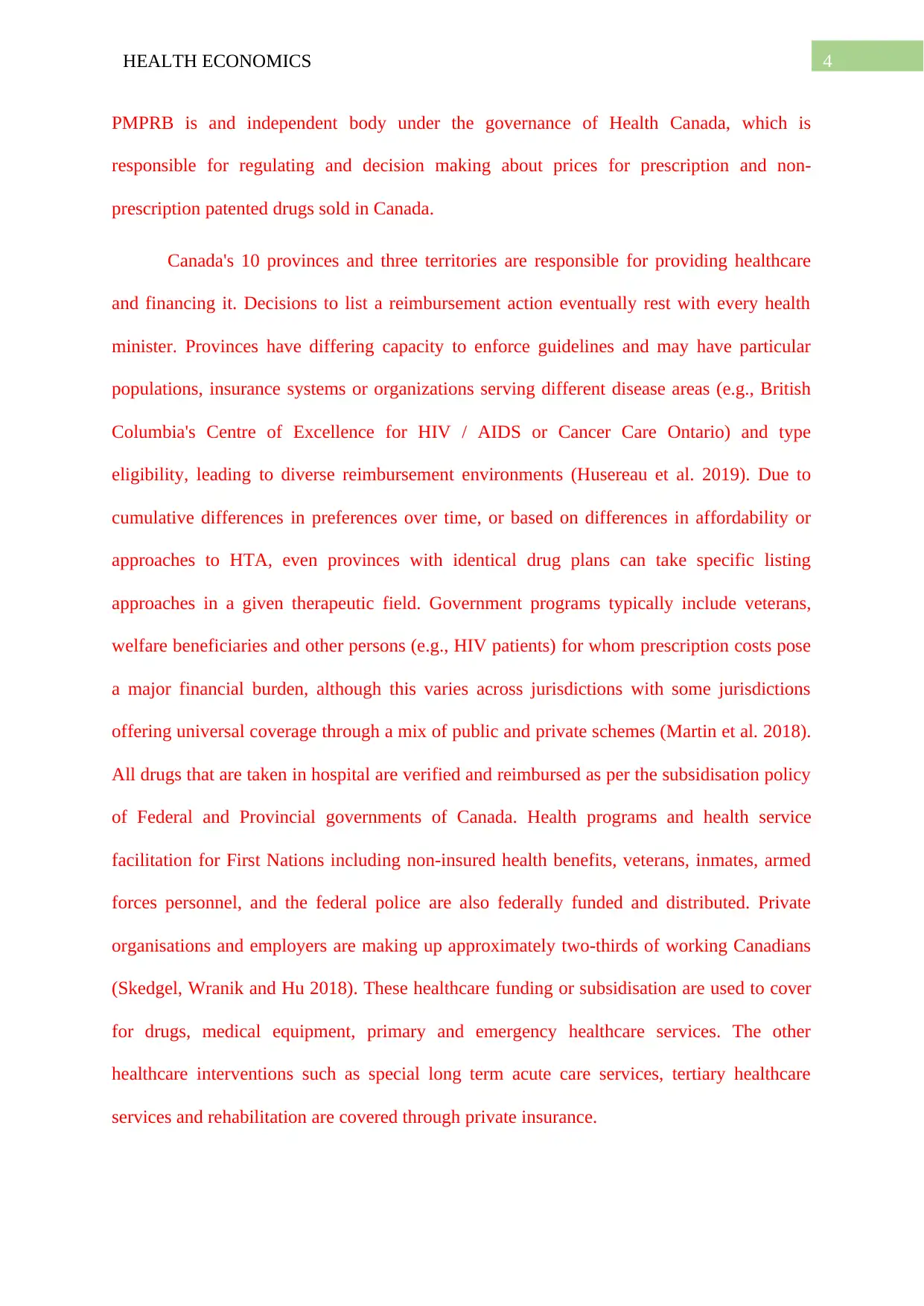
4HEALTH ECONOMICS
PMPRB is and independent body under the governance of Health Canada, which is
responsible for regulating and decision making about prices for prescription and non-
prescription patented drugs sold in Canada.
Canada's 10 provinces and three territories are responsible for providing healthcare
and financing it. Decisions to list a reimbursement action eventually rest with every health
minister. Provinces have differing capacity to enforce guidelines and may have particular
populations, insurance systems or organizations serving different disease areas (e.g., British
Columbia's Centre of Excellence for HIV / AIDS or Cancer Care Ontario) and type
eligibility, leading to diverse reimbursement environments (Husereau et al. 2019). Due to
cumulative differences in preferences over time, or based on differences in affordability or
approaches to HTA, even provinces with identical drug plans can take specific listing
approaches in a given therapeutic field. Government programs typically include veterans,
welfare beneficiaries and other persons (e.g., HIV patients) for whom prescription costs pose
a major financial burden, although this varies across jurisdictions with some jurisdictions
offering universal coverage through a mix of public and private schemes (Martin et al. 2018).
All drugs that are taken in hospital are verified and reimbursed as per the subsidisation policy
of Federal and Provincial governments of Canada. Health programs and health service
facilitation for First Nations including non-insured health benefits, veterans, inmates, armed
forces personnel, and the federal police are also federally funded and distributed. Private
organisations and employers are making up approximately two-thirds of working Canadians
(Skedgel, Wranik and Hu 2018). These healthcare funding or subsidisation are used to cover
for drugs, medical equipment, primary and emergency healthcare services. The other
healthcare interventions such as special long term acute care services, tertiary healthcare
services and rehabilitation are covered through private insurance.
PMPRB is and independent body under the governance of Health Canada, which is
responsible for regulating and decision making about prices for prescription and non-
prescription patented drugs sold in Canada.
Canada's 10 provinces and three territories are responsible for providing healthcare
and financing it. Decisions to list a reimbursement action eventually rest with every health
minister. Provinces have differing capacity to enforce guidelines and may have particular
populations, insurance systems or organizations serving different disease areas (e.g., British
Columbia's Centre of Excellence for HIV / AIDS or Cancer Care Ontario) and type
eligibility, leading to diverse reimbursement environments (Husereau et al. 2019). Due to
cumulative differences in preferences over time, or based on differences in affordability or
approaches to HTA, even provinces with identical drug plans can take specific listing
approaches in a given therapeutic field. Government programs typically include veterans,
welfare beneficiaries and other persons (e.g., HIV patients) for whom prescription costs pose
a major financial burden, although this varies across jurisdictions with some jurisdictions
offering universal coverage through a mix of public and private schemes (Martin et al. 2018).
All drugs that are taken in hospital are verified and reimbursed as per the subsidisation policy
of Federal and Provincial governments of Canada. Health programs and health service
facilitation for First Nations including non-insured health benefits, veterans, inmates, armed
forces personnel, and the federal police are also federally funded and distributed. Private
organisations and employers are making up approximately two-thirds of working Canadians
(Skedgel, Wranik and Hu 2018). These healthcare funding or subsidisation are used to cover
for drugs, medical equipment, primary and emergency healthcare services. The other
healthcare interventions such as special long term acute care services, tertiary healthcare
services and rehabilitation are covered through private insurance.
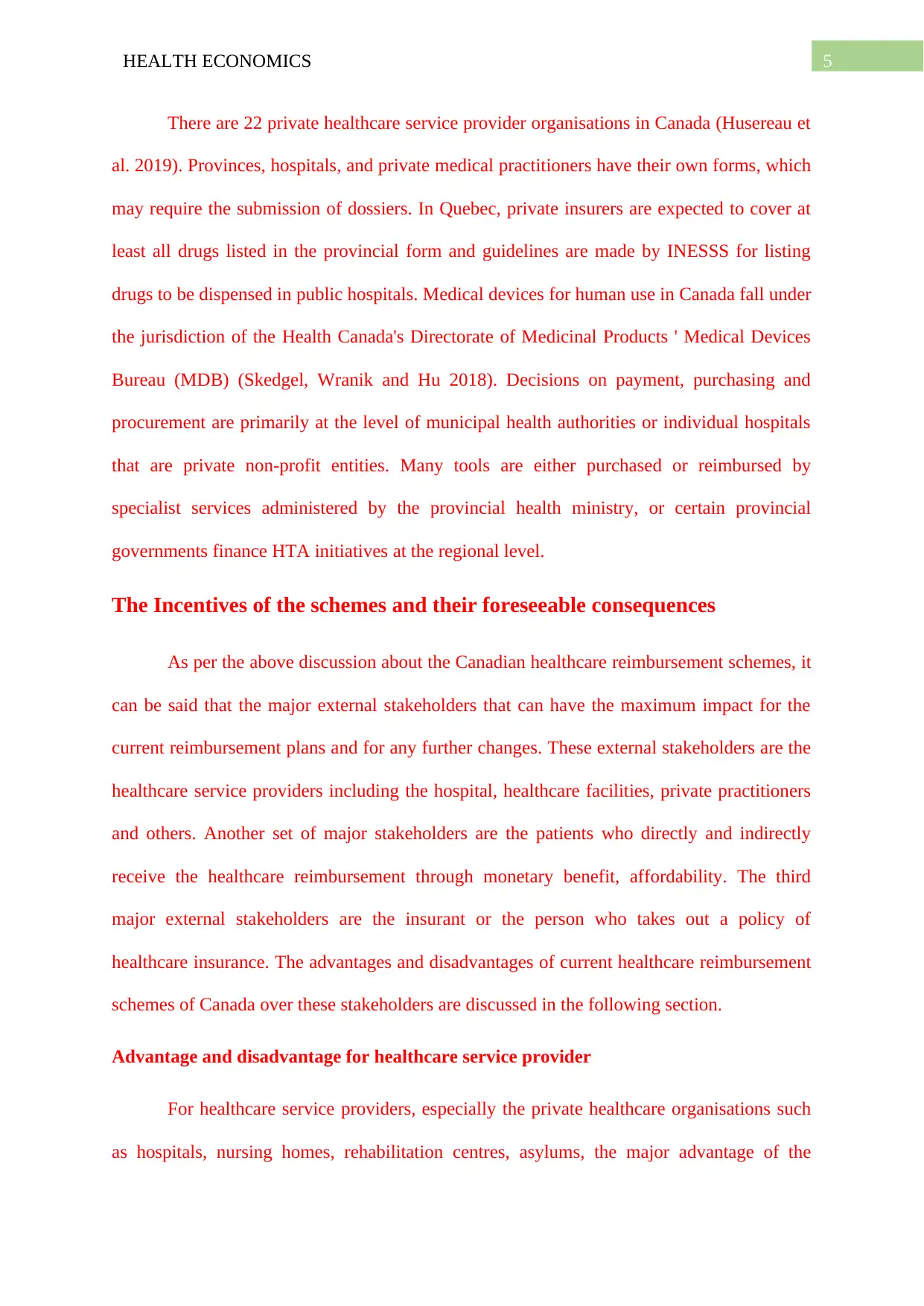
5HEALTH ECONOMICS
There are 22 private healthcare service provider organisations in Canada (Husereau et
al. 2019). Provinces, hospitals, and private medical practitioners have their own forms, which
may require the submission of dossiers. In Quebec, private insurers are expected to cover at
least all drugs listed in the provincial form and guidelines are made by INESSS for listing
drugs to be dispensed in public hospitals. Medical devices for human use in Canada fall under
the jurisdiction of the Health Canada's Directorate of Medicinal Products ' Medical Devices
Bureau (MDB) (Skedgel, Wranik and Hu 2018). Decisions on payment, purchasing and
procurement are primarily at the level of municipal health authorities or individual hospitals
that are private non-profit entities. Many tools are either purchased or reimbursed by
specialist services administered by the provincial health ministry, or certain provincial
governments finance HTA initiatives at the regional level.
The Incentives of the schemes and their foreseeable consequences
As per the above discussion about the Canadian healthcare reimbursement schemes, it
can be said that the major external stakeholders that can have the maximum impact for the
current reimbursement plans and for any further changes. These external stakeholders are the
healthcare service providers including the hospital, healthcare facilities, private practitioners
and others. Another set of major stakeholders are the patients who directly and indirectly
receive the healthcare reimbursement through monetary benefit, affordability. The third
major external stakeholders are the insurant or the person who takes out a policy of
healthcare insurance. The advantages and disadvantages of current healthcare reimbursement
schemes of Canada over these stakeholders are discussed in the following section.
Advantage and disadvantage for healthcare service provider
For healthcare service providers, especially the private healthcare organisations such
as hospitals, nursing homes, rehabilitation centres, asylums, the major advantage of the
There are 22 private healthcare service provider organisations in Canada (Husereau et
al. 2019). Provinces, hospitals, and private medical practitioners have their own forms, which
may require the submission of dossiers. In Quebec, private insurers are expected to cover at
least all drugs listed in the provincial form and guidelines are made by INESSS for listing
drugs to be dispensed in public hospitals. Medical devices for human use in Canada fall under
the jurisdiction of the Health Canada's Directorate of Medicinal Products ' Medical Devices
Bureau (MDB) (Skedgel, Wranik and Hu 2018). Decisions on payment, purchasing and
procurement are primarily at the level of municipal health authorities or individual hospitals
that are private non-profit entities. Many tools are either purchased or reimbursed by
specialist services administered by the provincial health ministry, or certain provincial
governments finance HTA initiatives at the regional level.
The Incentives of the schemes and their foreseeable consequences
As per the above discussion about the Canadian healthcare reimbursement schemes, it
can be said that the major external stakeholders that can have the maximum impact for the
current reimbursement plans and for any further changes. These external stakeholders are the
healthcare service providers including the hospital, healthcare facilities, private practitioners
and others. Another set of major stakeholders are the patients who directly and indirectly
receive the healthcare reimbursement through monetary benefit, affordability. The third
major external stakeholders are the insurant or the person who takes out a policy of
healthcare insurance. The advantages and disadvantages of current healthcare reimbursement
schemes of Canada over these stakeholders are discussed in the following section.
Advantage and disadvantage for healthcare service provider
For healthcare service providers, especially the private healthcare organisations such
as hospitals, nursing homes, rehabilitation centres, asylums, the major advantage of the
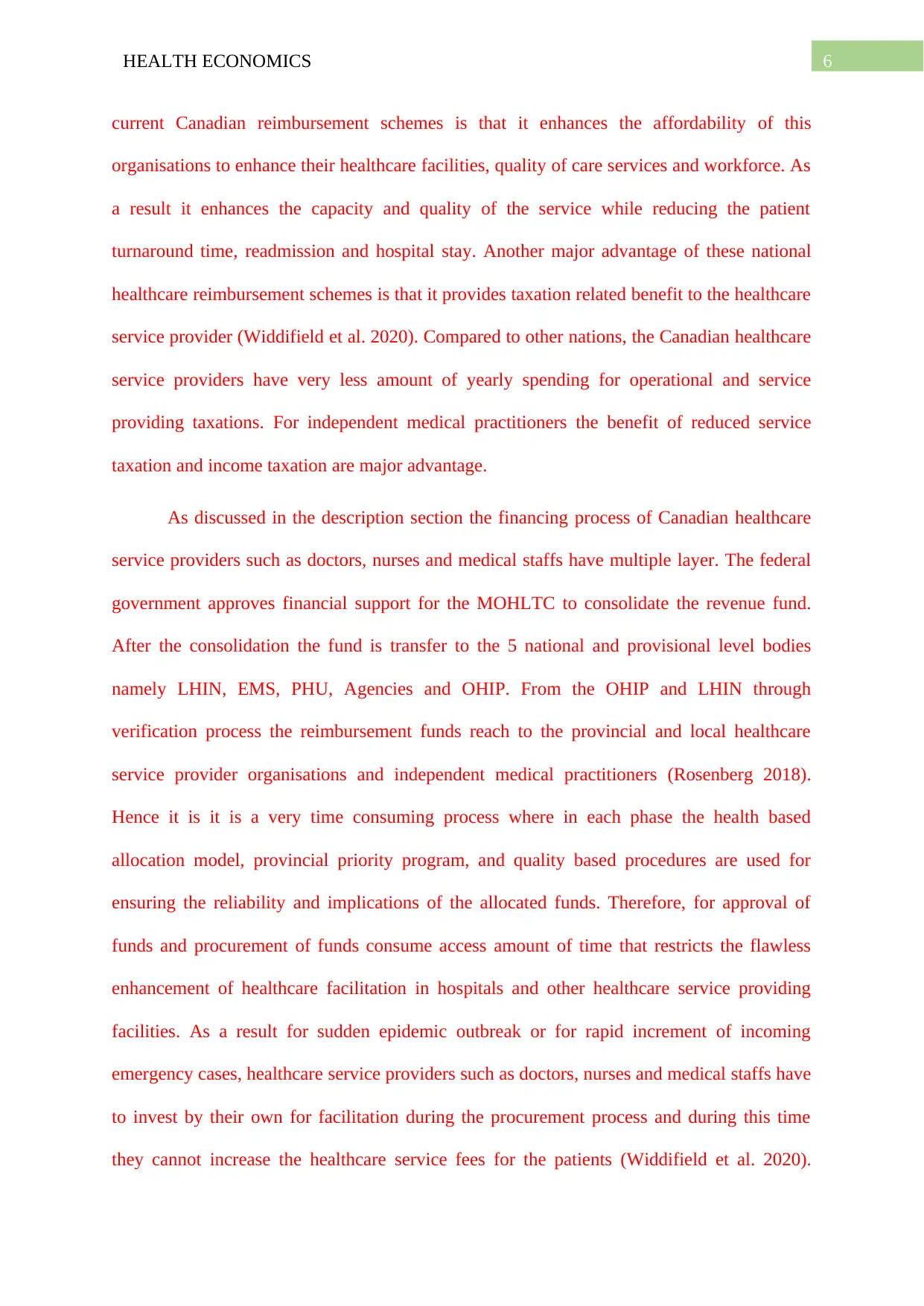
6HEALTH ECONOMICS
current Canadian reimbursement schemes is that it enhances the affordability of this
organisations to enhance their healthcare facilities, quality of care services and workforce. As
a result it enhances the capacity and quality of the service while reducing the patient
turnaround time, readmission and hospital stay. Another major advantage of these national
healthcare reimbursement schemes is that it provides taxation related benefit to the healthcare
service provider (Widdifield et al. 2020). Compared to other nations, the Canadian healthcare
service providers have very less amount of yearly spending for operational and service
providing taxations. For independent medical practitioners the benefit of reduced service
taxation and income taxation are major advantage.
As discussed in the description section the financing process of Canadian healthcare
service providers such as doctors, nurses and medical staffs have multiple layer. The federal
government approves financial support for the MOHLTC to consolidate the revenue fund.
After the consolidation the fund is transfer to the 5 national and provisional level bodies
namely LHIN, EMS, PHU, Agencies and OHIP. From the OHIP and LHIN through
verification process the reimbursement funds reach to the provincial and local healthcare
service provider organisations and independent medical practitioners (Rosenberg 2018).
Hence it is it is a very time consuming process where in each phase the health based
allocation model, provincial priority program, and quality based procedures are used for
ensuring the reliability and implications of the allocated funds. Therefore, for approval of
funds and procurement of funds consume access amount of time that restricts the flawless
enhancement of healthcare facilitation in hospitals and other healthcare service providing
facilities. As a result for sudden epidemic outbreak or for rapid increment of incoming
emergency cases, healthcare service providers such as doctors, nurses and medical staffs have
to invest by their own for facilitation during the procurement process and during this time
they cannot increase the healthcare service fees for the patients (Widdifield et al. 2020).
current Canadian reimbursement schemes is that it enhances the affordability of this
organisations to enhance their healthcare facilities, quality of care services and workforce. As
a result it enhances the capacity and quality of the service while reducing the patient
turnaround time, readmission and hospital stay. Another major advantage of these national
healthcare reimbursement schemes is that it provides taxation related benefit to the healthcare
service provider (Widdifield et al. 2020). Compared to other nations, the Canadian healthcare
service providers have very less amount of yearly spending for operational and service
providing taxations. For independent medical practitioners the benefit of reduced service
taxation and income taxation are major advantage.
As discussed in the description section the financing process of Canadian healthcare
service providers such as doctors, nurses and medical staffs have multiple layer. The federal
government approves financial support for the MOHLTC to consolidate the revenue fund.
After the consolidation the fund is transfer to the 5 national and provisional level bodies
namely LHIN, EMS, PHU, Agencies and OHIP. From the OHIP and LHIN through
verification process the reimbursement funds reach to the provincial and local healthcare
service provider organisations and independent medical practitioners (Rosenberg 2018).
Hence it is it is a very time consuming process where in each phase the health based
allocation model, provincial priority program, and quality based procedures are used for
ensuring the reliability and implications of the allocated funds. Therefore, for approval of
funds and procurement of funds consume access amount of time that restricts the flawless
enhancement of healthcare facilitation in hospitals and other healthcare service providing
facilities. As a result for sudden epidemic outbreak or for rapid increment of incoming
emergency cases, healthcare service providers such as doctors, nurses and medical staffs have
to invest by their own for facilitation during the procurement process and during this time
they cannot increase the healthcare service fees for the patients (Widdifield et al. 2020).
Paraphrase This Document
Need a fresh take? Get an instant paraphrase of this document with our AI Paraphraser
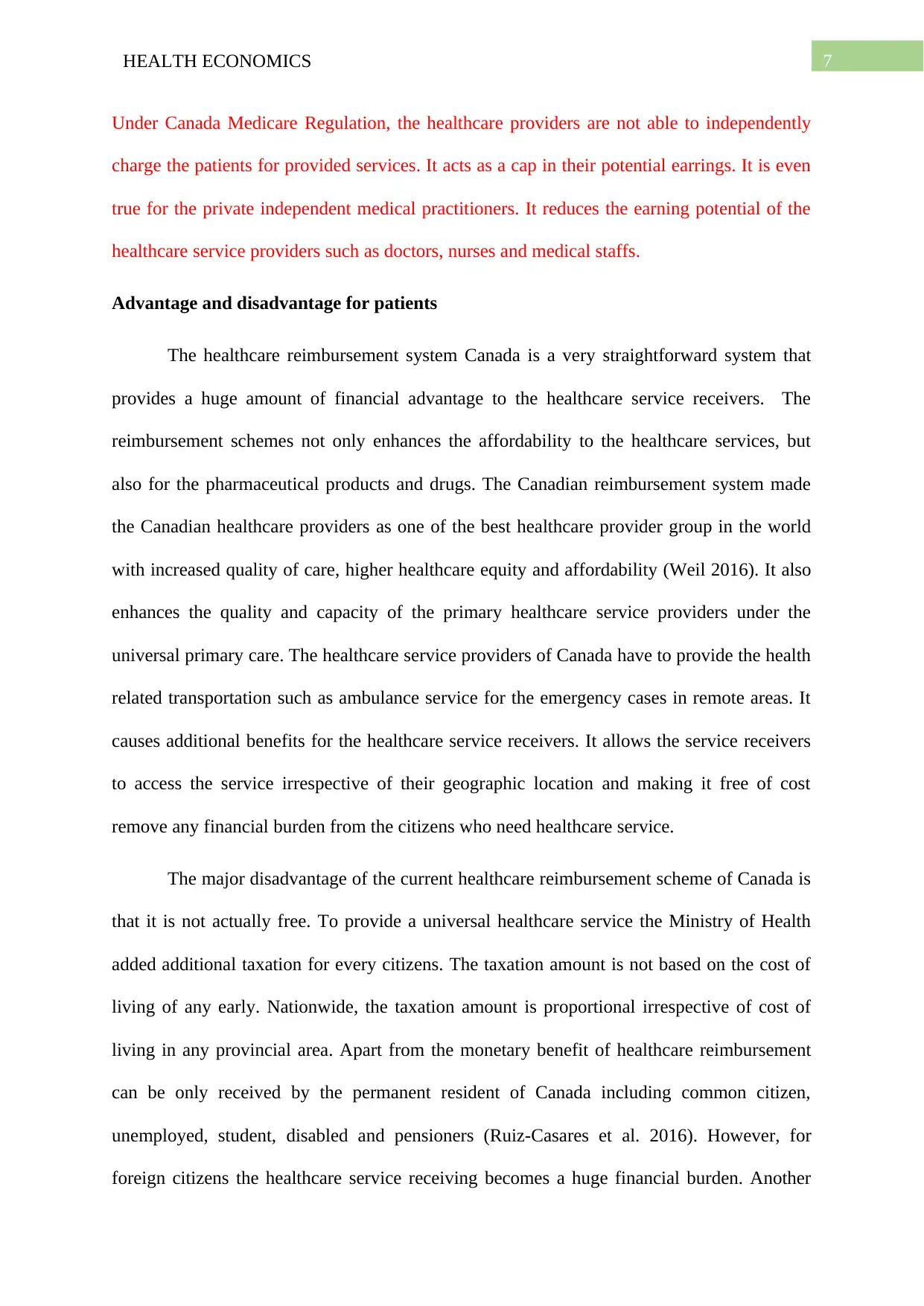
7HEALTH ECONOMICS
Under Canada Medicare Regulation, the healthcare providers are not able to independently
charge the patients for provided services. It acts as a cap in their potential earrings. It is even
true for the private independent medical practitioners. It reduces the earning potential of the
healthcare service providers such as doctors, nurses and medical staffs.
Advantage and disadvantage for patients
The healthcare reimbursement system Canada is a very straightforward system that
provides a huge amount of financial advantage to the healthcare service receivers. The
reimbursement schemes not only enhances the affordability to the healthcare services, but
also for the pharmaceutical products and drugs. The Canadian reimbursement system made
the Canadian healthcare providers as one of the best healthcare provider group in the world
with increased quality of care, higher healthcare equity and affordability (Weil 2016). It also
enhances the quality and capacity of the primary healthcare service providers under the
universal primary care. The healthcare service providers of Canada have to provide the health
related transportation such as ambulance service for the emergency cases in remote areas. It
causes additional benefits for the healthcare service receivers. It allows the service receivers
to access the service irrespective of their geographic location and making it free of cost
remove any financial burden from the citizens who need healthcare service.
The major disadvantage of the current healthcare reimbursement scheme of Canada is
that it is not actually free. To provide a universal healthcare service the Ministry of Health
added additional taxation for every citizens. The taxation amount is not based on the cost of
living of any early. Nationwide, the taxation amount is proportional irrespective of cost of
living in any provincial area. Apart from the monetary benefit of healthcare reimbursement
can be only received by the permanent resident of Canada including common citizen,
unemployed, student, disabled and pensioners (Ruiz-Casares et al. 2016). However, for
foreign citizens the healthcare service receiving becomes a huge financial burden. Another
Under Canada Medicare Regulation, the healthcare providers are not able to independently
charge the patients for provided services. It acts as a cap in their potential earrings. It is even
true for the private independent medical practitioners. It reduces the earning potential of the
healthcare service providers such as doctors, nurses and medical staffs.
Advantage and disadvantage for patients
The healthcare reimbursement system Canada is a very straightforward system that
provides a huge amount of financial advantage to the healthcare service receivers. The
reimbursement schemes not only enhances the affordability to the healthcare services, but
also for the pharmaceutical products and drugs. The Canadian reimbursement system made
the Canadian healthcare providers as one of the best healthcare provider group in the world
with increased quality of care, higher healthcare equity and affordability (Weil 2016). It also
enhances the quality and capacity of the primary healthcare service providers under the
universal primary care. The healthcare service providers of Canada have to provide the health
related transportation such as ambulance service for the emergency cases in remote areas. It
causes additional benefits for the healthcare service receivers. It allows the service receivers
to access the service irrespective of their geographic location and making it free of cost
remove any financial burden from the citizens who need healthcare service.
The major disadvantage of the current healthcare reimbursement scheme of Canada is
that it is not actually free. To provide a universal healthcare service the Ministry of Health
added additional taxation for every citizens. The taxation amount is not based on the cost of
living of any early. Nationwide, the taxation amount is proportional irrespective of cost of
living in any provincial area. Apart from the monetary benefit of healthcare reimbursement
can be only received by the permanent resident of Canada including common citizen,
unemployed, student, disabled and pensioners (Ruiz-Casares et al. 2016). However, for
foreign citizens the healthcare service receiving becomes a huge financial burden. Another
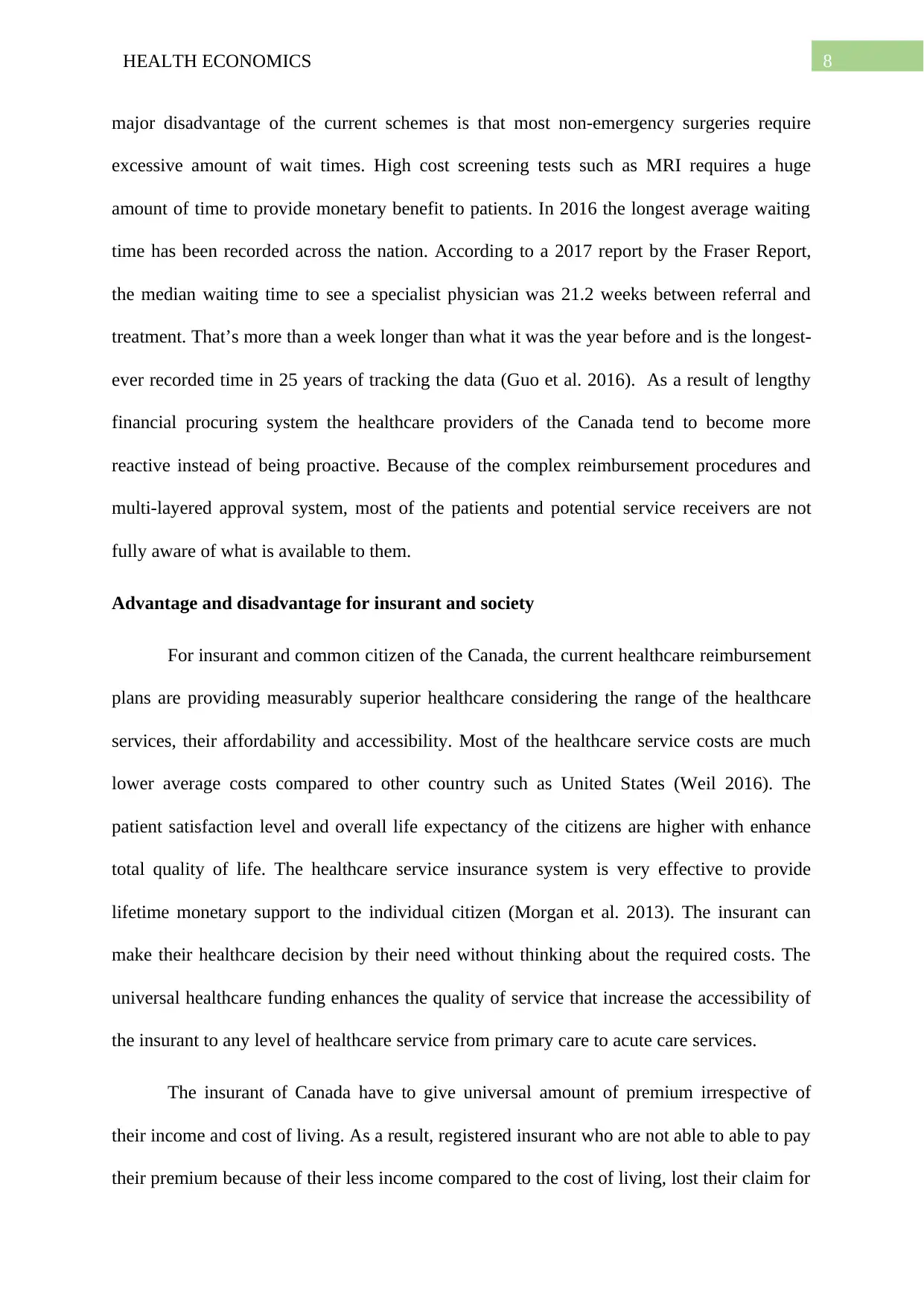
8HEALTH ECONOMICS
major disadvantage of the current schemes is that most non-emergency surgeries require
excessive amount of wait times. High cost screening tests such as MRI requires a huge
amount of time to provide monetary benefit to patients. In 2016 the longest average waiting
time has been recorded across the nation. According to a 2017 report by the Fraser Report,
the median waiting time to see a specialist physician was 21.2 weeks between referral and
treatment. That’s more than a week longer than what it was the year before and is the longest-
ever recorded time in 25 years of tracking the data (Guo et al. 2016). As a result of lengthy
financial procuring system the healthcare providers of the Canada tend to become more
reactive instead of being proactive. Because of the complex reimbursement procedures and
multi-layered approval system, most of the patients and potential service receivers are not
fully aware of what is available to them.
Advantage and disadvantage for insurant and society
For insurant and common citizen of the Canada, the current healthcare reimbursement
plans are providing measurably superior healthcare considering the range of the healthcare
services, their affordability and accessibility. Most of the healthcare service costs are much
lower average costs compared to other country such as United States (Weil 2016). The
patient satisfaction level and overall life expectancy of the citizens are higher with enhance
total quality of life. The healthcare service insurance system is very effective to provide
lifetime monetary support to the individual citizen (Morgan et al. 2013). The insurant can
make their healthcare decision by their need without thinking about the required costs. The
universal healthcare funding enhances the quality of service that increase the accessibility of
the insurant to any level of healthcare service from primary care to acute care services.
The insurant of Canada have to give universal amount of premium irrespective of
their income and cost of living. As a result, registered insurant who are not able to able to pay
their premium because of their less income compared to the cost of living, lost their claim for
major disadvantage of the current schemes is that most non-emergency surgeries require
excessive amount of wait times. High cost screening tests such as MRI requires a huge
amount of time to provide monetary benefit to patients. In 2016 the longest average waiting
time has been recorded across the nation. According to a 2017 report by the Fraser Report,
the median waiting time to see a specialist physician was 21.2 weeks between referral and
treatment. That’s more than a week longer than what it was the year before and is the longest-
ever recorded time in 25 years of tracking the data (Guo et al. 2016). As a result of lengthy
financial procuring system the healthcare providers of the Canada tend to become more
reactive instead of being proactive. Because of the complex reimbursement procedures and
multi-layered approval system, most of the patients and potential service receivers are not
fully aware of what is available to them.
Advantage and disadvantage for insurant and society
For insurant and common citizen of the Canada, the current healthcare reimbursement
plans are providing measurably superior healthcare considering the range of the healthcare
services, their affordability and accessibility. Most of the healthcare service costs are much
lower average costs compared to other country such as United States (Weil 2016). The
patient satisfaction level and overall life expectancy of the citizens are higher with enhance
total quality of life. The healthcare service insurance system is very effective to provide
lifetime monetary support to the individual citizen (Morgan et al. 2013). The insurant can
make their healthcare decision by their need without thinking about the required costs. The
universal healthcare funding enhances the quality of service that increase the accessibility of
the insurant to any level of healthcare service from primary care to acute care services.
The insurant of Canada have to give universal amount of premium irrespective of
their income and cost of living. As a result, registered insurant who are not able to able to pay
their premium because of their less income compared to the cost of living, lost their claim for
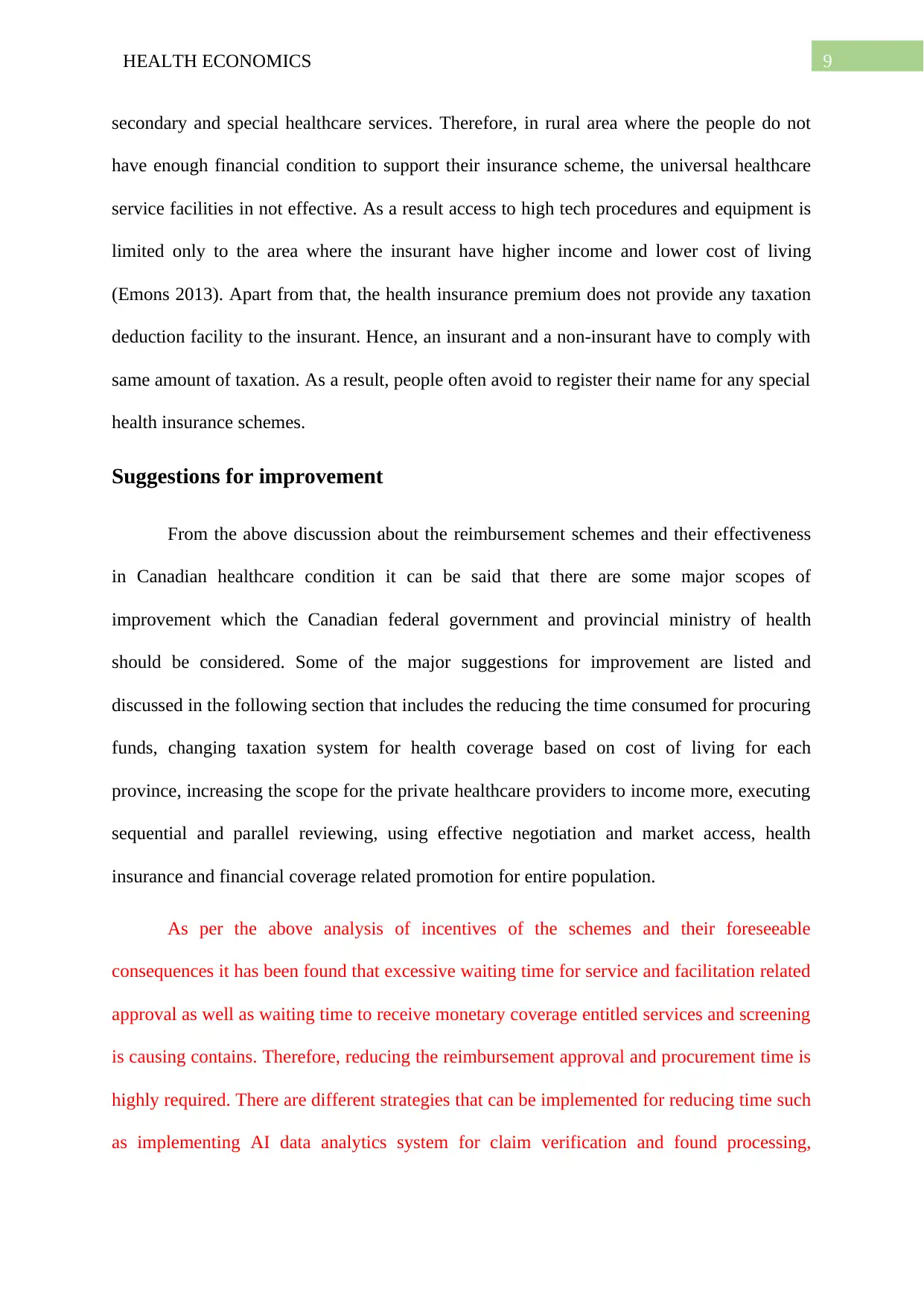
9HEALTH ECONOMICS
secondary and special healthcare services. Therefore, in rural area where the people do not
have enough financial condition to support their insurance scheme, the universal healthcare
service facilities in not effective. As a result access to high tech procedures and equipment is
limited only to the area where the insurant have higher income and lower cost of living
(Emons 2013). Apart from that, the health insurance premium does not provide any taxation
deduction facility to the insurant. Hence, an insurant and a non-insurant have to comply with
same amount of taxation. As a result, people often avoid to register their name for any special
health insurance schemes.
Suggestions for improvement
From the above discussion about the reimbursement schemes and their effectiveness
in Canadian healthcare condition it can be said that there are some major scopes of
improvement which the Canadian federal government and provincial ministry of health
should be considered. Some of the major suggestions for improvement are listed and
discussed in the following section that includes the reducing the time consumed for procuring
funds, changing taxation system for health coverage based on cost of living for each
province, increasing the scope for the private healthcare providers to income more, executing
sequential and parallel reviewing, using effective negotiation and market access, health
insurance and financial coverage related promotion for entire population.
As per the above analysis of incentives of the schemes and their foreseeable
consequences it has been found that excessive waiting time for service and facilitation related
approval as well as waiting time to receive monetary coverage entitled services and screening
is causing contains. Therefore, reducing the reimbursement approval and procurement time is
highly required. There are different strategies that can be implemented for reducing time such
as implementing AI data analytics system for claim verification and found processing,
secondary and special healthcare services. Therefore, in rural area where the people do not
have enough financial condition to support their insurance scheme, the universal healthcare
service facilities in not effective. As a result access to high tech procedures and equipment is
limited only to the area where the insurant have higher income and lower cost of living
(Emons 2013). Apart from that, the health insurance premium does not provide any taxation
deduction facility to the insurant. Hence, an insurant and a non-insurant have to comply with
same amount of taxation. As a result, people often avoid to register their name for any special
health insurance schemes.
Suggestions for improvement
From the above discussion about the reimbursement schemes and their effectiveness
in Canadian healthcare condition it can be said that there are some major scopes of
improvement which the Canadian federal government and provincial ministry of health
should be considered. Some of the major suggestions for improvement are listed and
discussed in the following section that includes the reducing the time consumed for procuring
funds, changing taxation system for health coverage based on cost of living for each
province, increasing the scope for the private healthcare providers to income more, executing
sequential and parallel reviewing, using effective negotiation and market access, health
insurance and financial coverage related promotion for entire population.
As per the above analysis of incentives of the schemes and their foreseeable
consequences it has been found that excessive waiting time for service and facilitation related
approval as well as waiting time to receive monetary coverage entitled services and screening
is causing contains. Therefore, reducing the reimbursement approval and procurement time is
highly required. There are different strategies that can be implemented for reducing time such
as implementing AI data analytics system for claim verification and found processing,
Secure Best Marks with AI Grader
Need help grading? Try our AI Grader for instant feedback on your assignments.
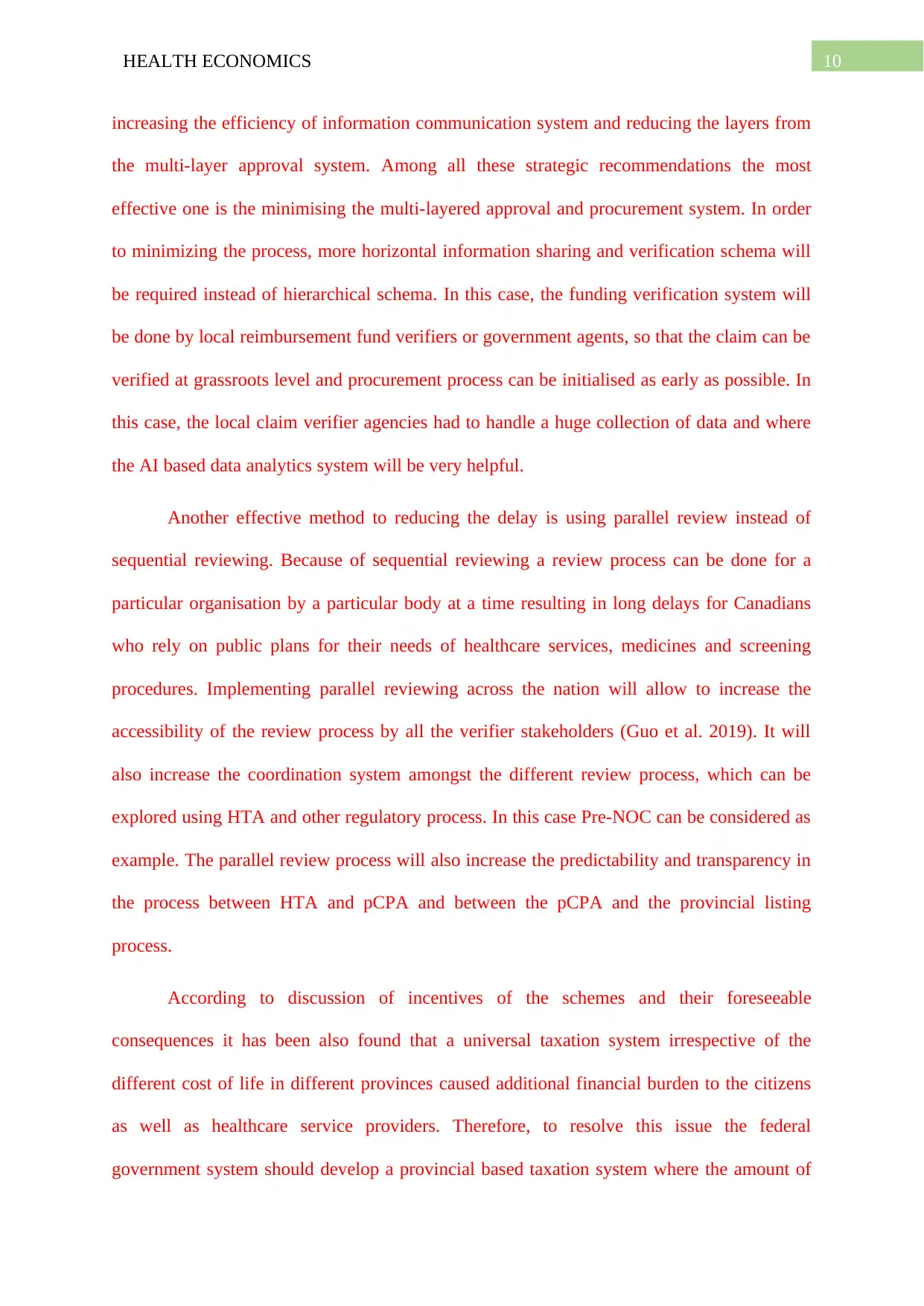
10HEALTH ECONOMICS
increasing the efficiency of information communication system and reducing the layers from
the multi-layer approval system. Among all these strategic recommendations the most
effective one is the minimising the multi-layered approval and procurement system. In order
to minimizing the process, more horizontal information sharing and verification schema will
be required instead of hierarchical schema. In this case, the funding verification system will
be done by local reimbursement fund verifiers or government agents, so that the claim can be
verified at grassroots level and procurement process can be initialised as early as possible. In
this case, the local claim verifier agencies had to handle a huge collection of data and where
the AI based data analytics system will be very helpful.
Another effective method to reducing the delay is using parallel review instead of
sequential reviewing. Because of sequential reviewing a review process can be done for a
particular organisation by a particular body at a time resulting in long delays for Canadians
who rely on public plans for their needs of healthcare services, medicines and screening
procedures. Implementing parallel reviewing across the nation will allow to increase the
accessibility of the review process by all the verifier stakeholders (Guo et al. 2019). It will
also increase the coordination system amongst the different review process, which can be
explored using HTA and other regulatory process. In this case Pre-NOC can be considered as
example. The parallel review process will also increase the predictability and transparency in
the process between HTA and pCPA and between the pCPA and the provincial listing
process.
According to discussion of incentives of the schemes and their foreseeable
consequences it has been also found that a universal taxation system irrespective of the
different cost of life in different provinces caused additional financial burden to the citizens
as well as healthcare service providers. Therefore, to resolve this issue the federal
government system should develop a provincial based taxation system where the amount of
increasing the efficiency of information communication system and reducing the layers from
the multi-layer approval system. Among all these strategic recommendations the most
effective one is the minimising the multi-layered approval and procurement system. In order
to minimizing the process, more horizontal information sharing and verification schema will
be required instead of hierarchical schema. In this case, the funding verification system will
be done by local reimbursement fund verifiers or government agents, so that the claim can be
verified at grassroots level and procurement process can be initialised as early as possible. In
this case, the local claim verifier agencies had to handle a huge collection of data and where
the AI based data analytics system will be very helpful.
Another effective method to reducing the delay is using parallel review instead of
sequential reviewing. Because of sequential reviewing a review process can be done for a
particular organisation by a particular body at a time resulting in long delays for Canadians
who rely on public plans for their needs of healthcare services, medicines and screening
procedures. Implementing parallel reviewing across the nation will allow to increase the
accessibility of the review process by all the verifier stakeholders (Guo et al. 2019). It will
also increase the coordination system amongst the different review process, which can be
explored using HTA and other regulatory process. In this case Pre-NOC can be considered as
example. The parallel review process will also increase the predictability and transparency in
the process between HTA and pCPA and between the pCPA and the provincial listing
process.
According to discussion of incentives of the schemes and their foreseeable
consequences it has been also found that a universal taxation system irrespective of the
different cost of life in different provinces caused additional financial burden to the citizens
as well as healthcare service providers. Therefore, to resolve this issue the federal
government system should develop a provincial based taxation system where the amount of
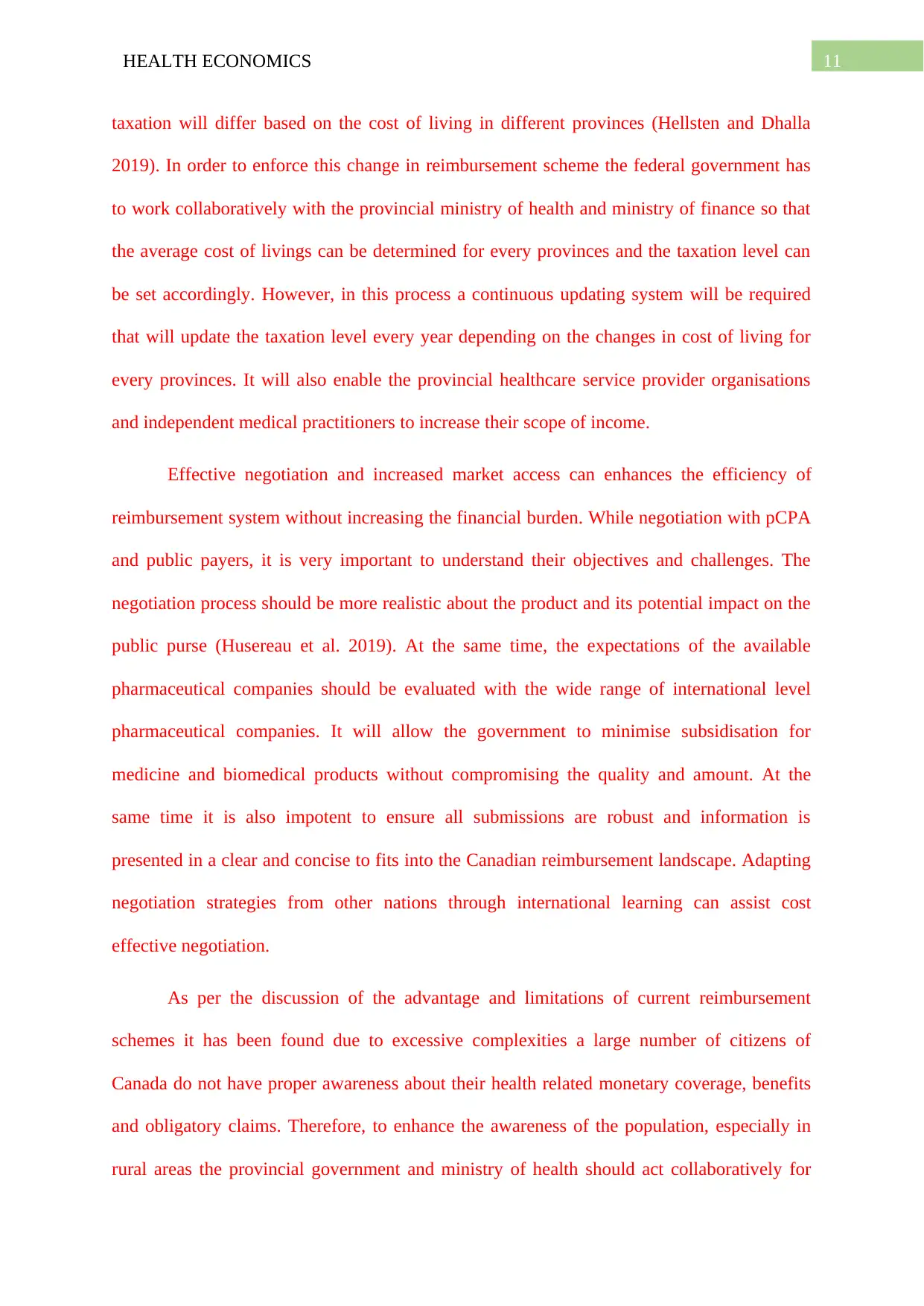
11HEALTH ECONOMICS
taxation will differ based on the cost of living in different provinces (Hellsten and Dhalla
2019). In order to enforce this change in reimbursement scheme the federal government has
to work collaboratively with the provincial ministry of health and ministry of finance so that
the average cost of livings can be determined for every provinces and the taxation level can
be set accordingly. However, in this process a continuous updating system will be required
that will update the taxation level every year depending on the changes in cost of living for
every provinces. It will also enable the provincial healthcare service provider organisations
and independent medical practitioners to increase their scope of income.
Effective negotiation and increased market access can enhances the efficiency of
reimbursement system without increasing the financial burden. While negotiation with pCPA
and public payers, it is very important to understand their objectives and challenges. The
negotiation process should be more realistic about the product and its potential impact on the
public purse (Husereau et al. 2019). At the same time, the expectations of the available
pharmaceutical companies should be evaluated with the wide range of international level
pharmaceutical companies. It will allow the government to minimise subsidisation for
medicine and biomedical products without compromising the quality and amount. At the
same time it is also impotent to ensure all submissions are robust and information is
presented in a clear and concise to fits into the Canadian reimbursement landscape. Adapting
negotiation strategies from other nations through international learning can assist cost
effective negotiation.
As per the discussion of the advantage and limitations of current reimbursement
schemes it has been found due to excessive complexities a large number of citizens of
Canada do not have proper awareness about their health related monetary coverage, benefits
and obligatory claims. Therefore, to enhance the awareness of the population, especially in
rural areas the provincial government and ministry of health should act collaboratively for
taxation will differ based on the cost of living in different provinces (Hellsten and Dhalla
2019). In order to enforce this change in reimbursement scheme the federal government has
to work collaboratively with the provincial ministry of health and ministry of finance so that
the average cost of livings can be determined for every provinces and the taxation level can
be set accordingly. However, in this process a continuous updating system will be required
that will update the taxation level every year depending on the changes in cost of living for
every provinces. It will also enable the provincial healthcare service provider organisations
and independent medical practitioners to increase their scope of income.
Effective negotiation and increased market access can enhances the efficiency of
reimbursement system without increasing the financial burden. While negotiation with pCPA
and public payers, it is very important to understand their objectives and challenges. The
negotiation process should be more realistic about the product and its potential impact on the
public purse (Husereau et al. 2019). At the same time, the expectations of the available
pharmaceutical companies should be evaluated with the wide range of international level
pharmaceutical companies. It will allow the government to minimise subsidisation for
medicine and biomedical products without compromising the quality and amount. At the
same time it is also impotent to ensure all submissions are robust and information is
presented in a clear and concise to fits into the Canadian reimbursement landscape. Adapting
negotiation strategies from other nations through international learning can assist cost
effective negotiation.
As per the discussion of the advantage and limitations of current reimbursement
schemes it has been found due to excessive complexities a large number of citizens of
Canada do not have proper awareness about their health related monetary coverage, benefits
and obligatory claims. Therefore, to enhance the awareness of the population, especially in
rural areas the provincial government and ministry of health should act collaboratively for
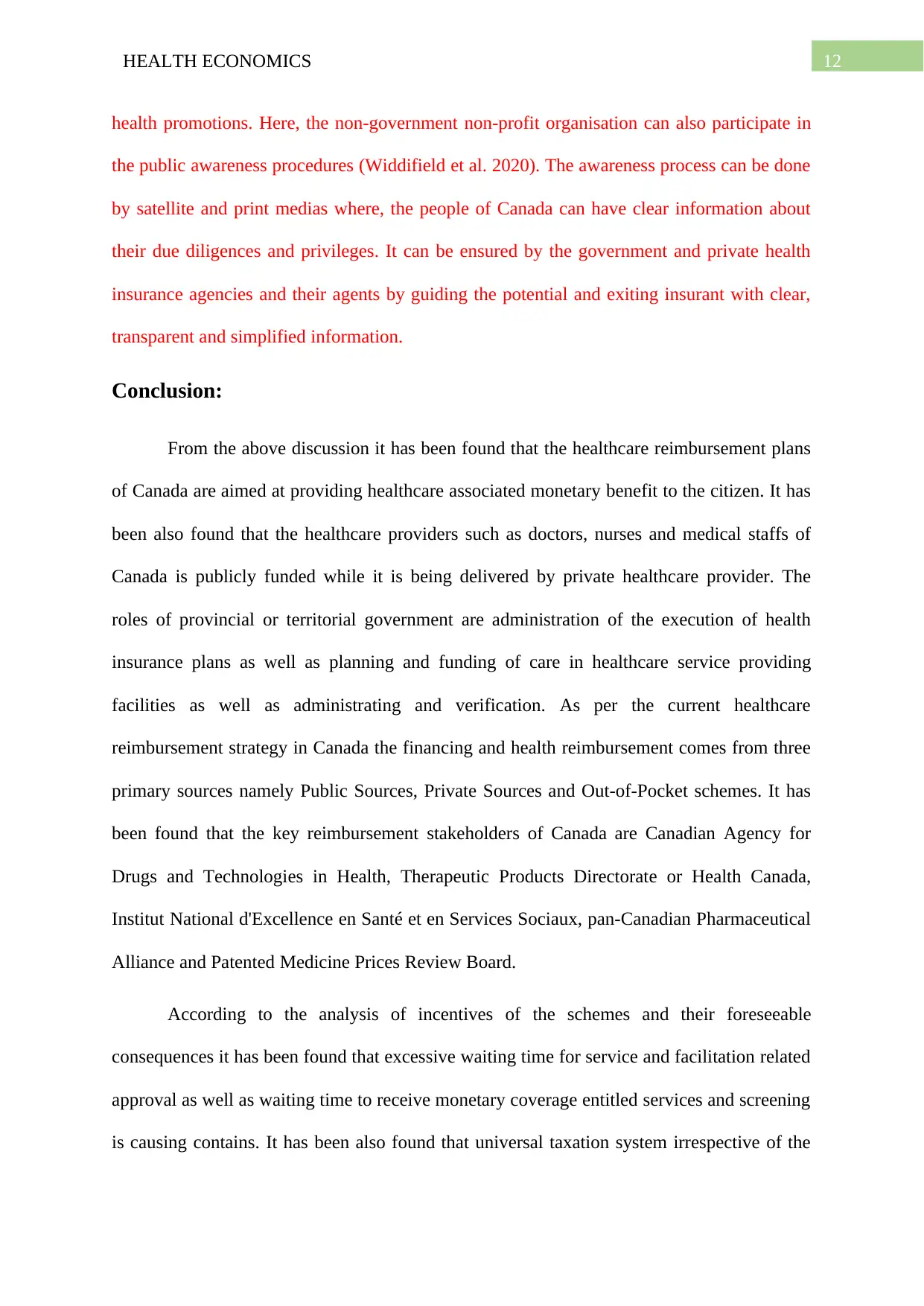
12HEALTH ECONOMICS
health promotions. Here, the non-government non-profit organisation can also participate in
the public awareness procedures (Widdifield et al. 2020). The awareness process can be done
by satellite and print medias where, the people of Canada can have clear information about
their due diligences and privileges. It can be ensured by the government and private health
insurance agencies and their agents by guiding the potential and exiting insurant with clear,
transparent and simplified information.
Conclusion:
From the above discussion it has been found that the healthcare reimbursement plans
of Canada are aimed at providing healthcare associated monetary benefit to the citizen. It has
been also found that the healthcare providers such as doctors, nurses and medical staffs of
Canada is publicly funded while it is being delivered by private healthcare provider. The
roles of provincial or territorial government are administration of the execution of health
insurance plans as well as planning and funding of care in healthcare service providing
facilities as well as administrating and verification. As per the current healthcare
reimbursement strategy in Canada the financing and health reimbursement comes from three
primary sources namely Public Sources, Private Sources and Out-of-Pocket schemes. It has
been found that the key reimbursement stakeholders of Canada are Canadian Agency for
Drugs and Technologies in Health, Therapeutic Products Directorate or Health Canada,
Institut National d'Excellence en Santé et en Services Sociaux, pan-Canadian Pharmaceutical
Alliance and Patented Medicine Prices Review Board.
According to the analysis of incentives of the schemes and their foreseeable
consequences it has been found that excessive waiting time for service and facilitation related
approval as well as waiting time to receive monetary coverage entitled services and screening
is causing contains. It has been also found that universal taxation system irrespective of the
health promotions. Here, the non-government non-profit organisation can also participate in
the public awareness procedures (Widdifield et al. 2020). The awareness process can be done
by satellite and print medias where, the people of Canada can have clear information about
their due diligences and privileges. It can be ensured by the government and private health
insurance agencies and their agents by guiding the potential and exiting insurant with clear,
transparent and simplified information.
Conclusion:
From the above discussion it has been found that the healthcare reimbursement plans
of Canada are aimed at providing healthcare associated monetary benefit to the citizen. It has
been also found that the healthcare providers such as doctors, nurses and medical staffs of
Canada is publicly funded while it is being delivered by private healthcare provider. The
roles of provincial or territorial government are administration of the execution of health
insurance plans as well as planning and funding of care in healthcare service providing
facilities as well as administrating and verification. As per the current healthcare
reimbursement strategy in Canada the financing and health reimbursement comes from three
primary sources namely Public Sources, Private Sources and Out-of-Pocket schemes. It has
been found that the key reimbursement stakeholders of Canada are Canadian Agency for
Drugs and Technologies in Health, Therapeutic Products Directorate or Health Canada,
Institut National d'Excellence en Santé et en Services Sociaux, pan-Canadian Pharmaceutical
Alliance and Patented Medicine Prices Review Board.
According to the analysis of incentives of the schemes and their foreseeable
consequences it has been found that excessive waiting time for service and facilitation related
approval as well as waiting time to receive monetary coverage entitled services and screening
is causing contains. It has been also found that universal taxation system irrespective of the
Paraphrase This Document
Need a fresh take? Get an instant paraphrase of this document with our AI Paraphraser
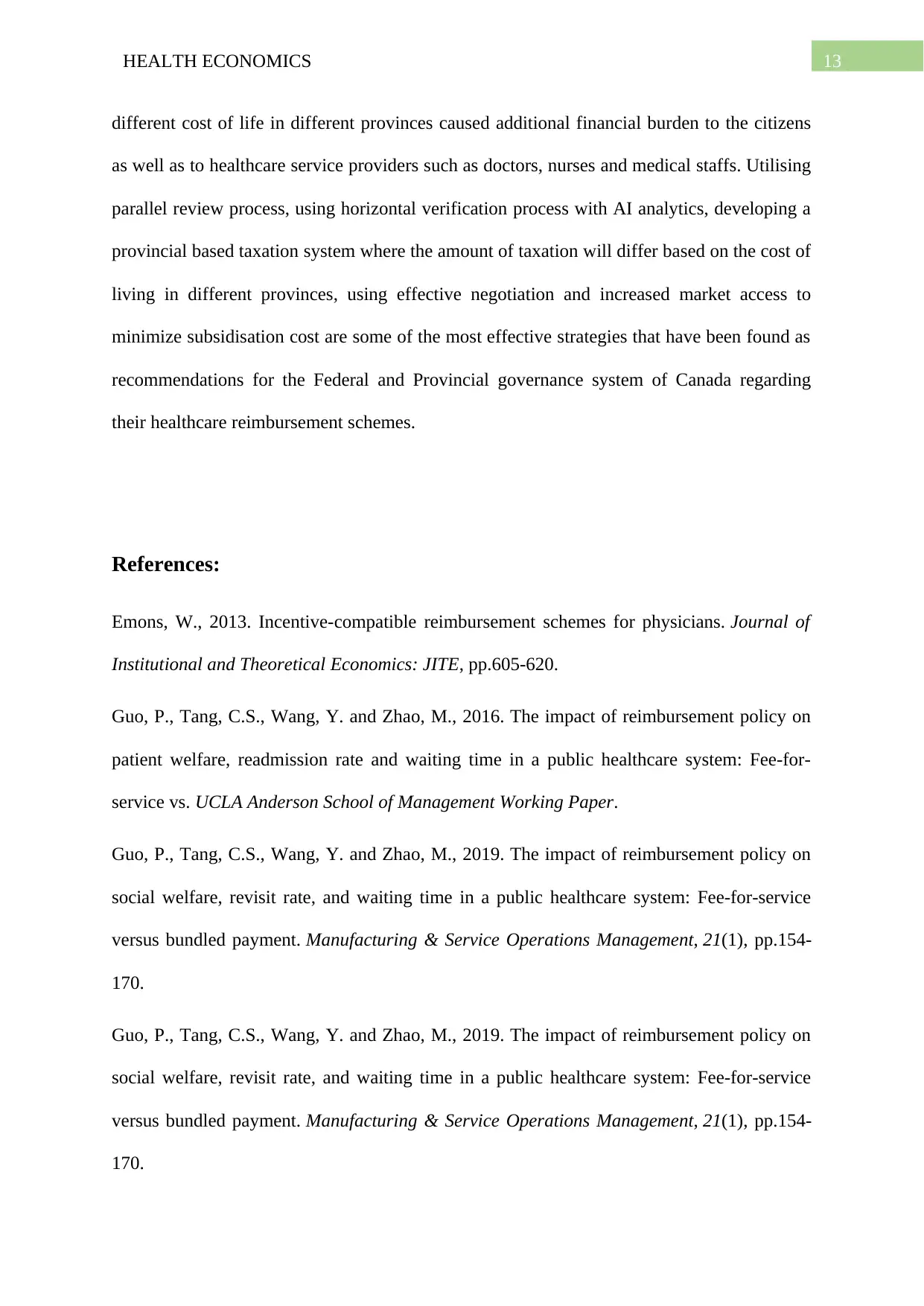
13HEALTH ECONOMICS
different cost of life in different provinces caused additional financial burden to the citizens
as well as to healthcare service providers such as doctors, nurses and medical staffs. Utilising
parallel review process, using horizontal verification process with AI analytics, developing a
provincial based taxation system where the amount of taxation will differ based on the cost of
living in different provinces, using effective negotiation and increased market access to
minimize subsidisation cost are some of the most effective strategies that have been found as
recommendations for the Federal and Provincial governance system of Canada regarding
their healthcare reimbursement schemes.
References:
Emons, W., 2013. Incentive-compatible reimbursement schemes for physicians. Journal of
Institutional and Theoretical Economics: JITE, pp.605-620.
Guo, P., Tang, C.S., Wang, Y. and Zhao, M., 2016. The impact of reimbursement policy on
patient welfare, readmission rate and waiting time in a public healthcare system: Fee-for-
service vs. UCLA Anderson School of Management Working Paper.
Guo, P., Tang, C.S., Wang, Y. and Zhao, M., 2019. The impact of reimbursement policy on
social welfare, revisit rate, and waiting time in a public healthcare system: Fee-for-service
versus bundled payment. Manufacturing & Service Operations Management, 21(1), pp.154-
170.
Guo, P., Tang, C.S., Wang, Y. and Zhao, M., 2019. The impact of reimbursement policy on
social welfare, revisit rate, and waiting time in a public healthcare system: Fee-for-service
versus bundled payment. Manufacturing & Service Operations Management, 21(1), pp.154-
170.
different cost of life in different provinces caused additional financial burden to the citizens
as well as to healthcare service providers such as doctors, nurses and medical staffs. Utilising
parallel review process, using horizontal verification process with AI analytics, developing a
provincial based taxation system where the amount of taxation will differ based on the cost of
living in different provinces, using effective negotiation and increased market access to
minimize subsidisation cost are some of the most effective strategies that have been found as
recommendations for the Federal and Provincial governance system of Canada regarding
their healthcare reimbursement schemes.
References:
Emons, W., 2013. Incentive-compatible reimbursement schemes for physicians. Journal of
Institutional and Theoretical Economics: JITE, pp.605-620.
Guo, P., Tang, C.S., Wang, Y. and Zhao, M., 2016. The impact of reimbursement policy on
patient welfare, readmission rate and waiting time in a public healthcare system: Fee-for-
service vs. UCLA Anderson School of Management Working Paper.
Guo, P., Tang, C.S., Wang, Y. and Zhao, M., 2019. The impact of reimbursement policy on
social welfare, revisit rate, and waiting time in a public healthcare system: Fee-for-service
versus bundled payment. Manufacturing & Service Operations Management, 21(1), pp.154-
170.
Guo, P., Tang, C.S., Wang, Y. and Zhao, M., 2019. The impact of reimbursement policy on
social welfare, revisit rate, and waiting time in a public healthcare system: Fee-for-service
versus bundled payment. Manufacturing & Service Operations Management, 21(1), pp.154-
170.
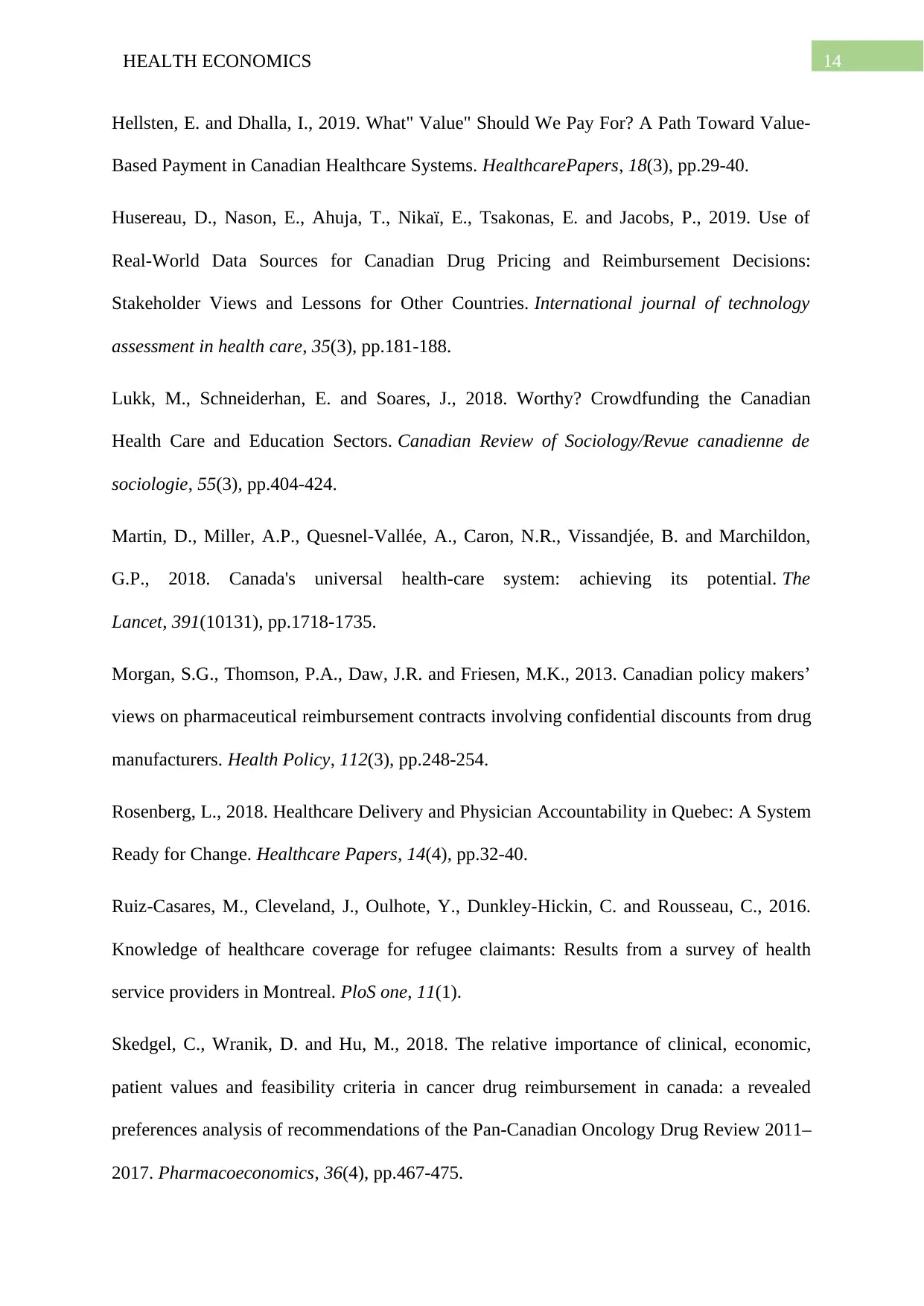
14HEALTH ECONOMICS
Hellsten, E. and Dhalla, I., 2019. What" Value" Should We Pay For? A Path Toward Value-
Based Payment in Canadian Healthcare Systems. HealthcarePapers, 18(3), pp.29-40.
Husereau, D., Nason, E., Ahuja, T., Nikaï, E., Tsakonas, E. and Jacobs, P., 2019. Use of
Real-World Data Sources for Canadian Drug Pricing and Reimbursement Decisions:
Stakeholder Views and Lessons for Other Countries. International journal of technology
assessment in health care, 35(3), pp.181-188.
Lukk, M., Schneiderhan, E. and Soares, J., 2018. Worthy? Crowdfunding the Canadian
Health Care and Education Sectors. Canadian Review of Sociology/Revue canadienne de
sociologie, 55(3), pp.404-424.
Martin, D., Miller, A.P., Quesnel-Vallée, A., Caron, N.R., Vissandjée, B. and Marchildon,
G.P., 2018. Canada's universal health-care system: achieving its potential. The
Lancet, 391(10131), pp.1718-1735.
Morgan, S.G., Thomson, P.A., Daw, J.R. and Friesen, M.K., 2013. Canadian policy makers’
views on pharmaceutical reimbursement contracts involving confidential discounts from drug
manufacturers. Health Policy, 112(3), pp.248-254.
Rosenberg, L., 2018. Healthcare Delivery and Physician Accountability in Quebec: A System
Ready for Change. Healthcare Papers, 14(4), pp.32-40.
Ruiz-Casares, M., Cleveland, J., Oulhote, Y., Dunkley-Hickin, C. and Rousseau, C., 2016.
Knowledge of healthcare coverage for refugee claimants: Results from a survey of health
service providers in Montreal. PloS one, 11(1).
Skedgel, C., Wranik, D. and Hu, M., 2018. The relative importance of clinical, economic,
patient values and feasibility criteria in cancer drug reimbursement in canada: a revealed
preferences analysis of recommendations of the Pan-Canadian Oncology Drug Review 2011–
2017. Pharmacoeconomics, 36(4), pp.467-475.
Hellsten, E. and Dhalla, I., 2019. What" Value" Should We Pay For? A Path Toward Value-
Based Payment in Canadian Healthcare Systems. HealthcarePapers, 18(3), pp.29-40.
Husereau, D., Nason, E., Ahuja, T., Nikaï, E., Tsakonas, E. and Jacobs, P., 2019. Use of
Real-World Data Sources for Canadian Drug Pricing and Reimbursement Decisions:
Stakeholder Views and Lessons for Other Countries. International journal of technology
assessment in health care, 35(3), pp.181-188.
Lukk, M., Schneiderhan, E. and Soares, J., 2018. Worthy? Crowdfunding the Canadian
Health Care and Education Sectors. Canadian Review of Sociology/Revue canadienne de
sociologie, 55(3), pp.404-424.
Martin, D., Miller, A.P., Quesnel-Vallée, A., Caron, N.R., Vissandjée, B. and Marchildon,
G.P., 2018. Canada's universal health-care system: achieving its potential. The
Lancet, 391(10131), pp.1718-1735.
Morgan, S.G., Thomson, P.A., Daw, J.R. and Friesen, M.K., 2013. Canadian policy makers’
views on pharmaceutical reimbursement contracts involving confidential discounts from drug
manufacturers. Health Policy, 112(3), pp.248-254.
Rosenberg, L., 2018. Healthcare Delivery and Physician Accountability in Quebec: A System
Ready for Change. Healthcare Papers, 14(4), pp.32-40.
Ruiz-Casares, M., Cleveland, J., Oulhote, Y., Dunkley-Hickin, C. and Rousseau, C., 2016.
Knowledge of healthcare coverage for refugee claimants: Results from a survey of health
service providers in Montreal. PloS one, 11(1).
Skedgel, C., Wranik, D. and Hu, M., 2018. The relative importance of clinical, economic,
patient values and feasibility criteria in cancer drug reimbursement in canada: a revealed
preferences analysis of recommendations of the Pan-Canadian Oncology Drug Review 2011–
2017. Pharmacoeconomics, 36(4), pp.467-475.
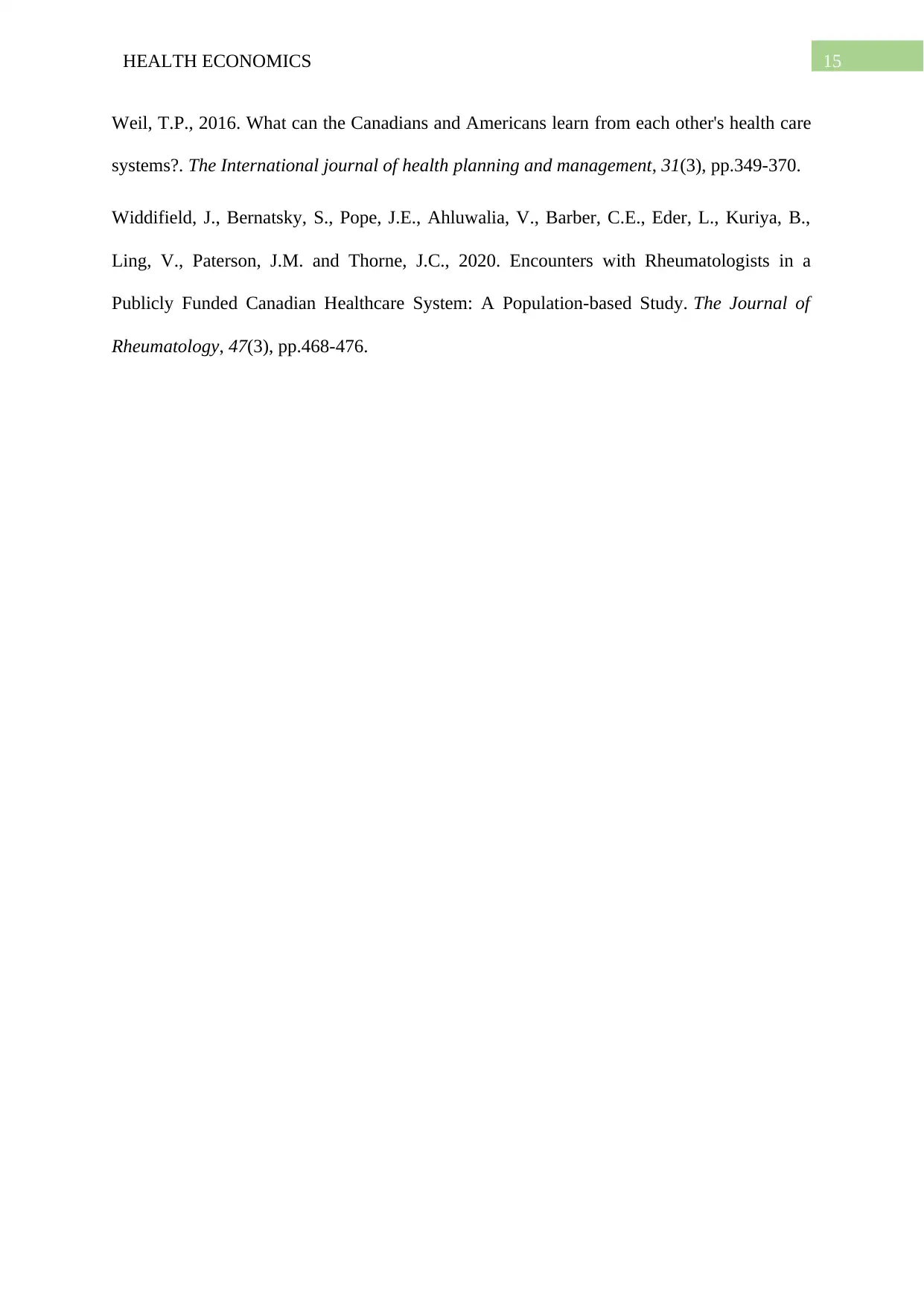
15HEALTH ECONOMICS
Weil, T.P., 2016. What can the Canadians and Americans learn from each other's health care
systems?. The International journal of health planning and management, 31(3), pp.349-370.
Widdifield, J., Bernatsky, S., Pope, J.E., Ahluwalia, V., Barber, C.E., Eder, L., Kuriya, B.,
Ling, V., Paterson, J.M. and Thorne, J.C., 2020. Encounters with Rheumatologists in a
Publicly Funded Canadian Healthcare System: A Population-based Study. The Journal of
Rheumatology, 47(3), pp.468-476.
Weil, T.P., 2016. What can the Canadians and Americans learn from each other's health care
systems?. The International journal of health planning and management, 31(3), pp.349-370.
Widdifield, J., Bernatsky, S., Pope, J.E., Ahluwalia, V., Barber, C.E., Eder, L., Kuriya, B.,
Ling, V., Paterson, J.M. and Thorne, J.C., 2020. Encounters with Rheumatologists in a
Publicly Funded Canadian Healthcare System: A Population-based Study. The Journal of
Rheumatology, 47(3), pp.468-476.
1 out of 16
Related Documents
Your All-in-One AI-Powered Toolkit for Academic Success.
+13062052269
info@desklib.com
Available 24*7 on WhatsApp / Email
![[object Object]](/_next/static/media/star-bottom.7253800d.svg)
Unlock your academic potential
© 2024 | Zucol Services PVT LTD | All rights reserved.





